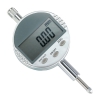Change Gears for ThreadingThe series of gears that drive the lead screw are called change gears because you change them to turn different thread pitches. Changing these gears varies the speed that the lead screw turns in relation to the speed that the spindle turns. This allows you to cut threads with different numbers of threads per inch. This calculator determines the correct change gears for any thread pitch. In some cases, the combination of gears given will produce an approximation of the pitch you need. In these cases the error from the desired pitch is shown. Note that in most cases these variations are very small and the resulting thread will meet industry standards. Change Gear CalculatorMake the choices to define your lathe below before calculating a thread pitch.
|

 Electronic Digital Indicator, 0.5"
Electronic Digital Indicator, 0.5" Die Set, 0-80 to 5-40 Threads
Die Set, 0-80 to 5-40 Threads
